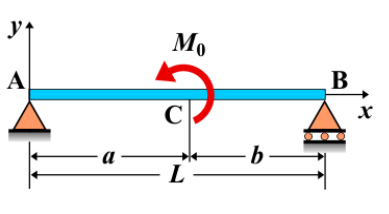Simple beam - Couple moment Mo at any point Calculator

Results:
Simple Beam - Couple Moment Mo at Any Point
A simple beam is supported at both ends, and a couple moment is a moment that acts to cause rotation without translating the beam. When a couple moment \( M_0 \) is applied at any point along the length of a simple beam, it induces internal moments but does not produce any shear force. The couple moment causes bending along the beam, with a bending moment diagram that shows a uniform distribution of the moment along the length of the beam, except at the point where the couple is applied.
Key Concepts
- Simple Beam: A beam supported at both ends, with no intermediate supports.
- Couple Moment: A pair of equal and opposite forces acting at a distance, creating a rotational effect without causing a shear force. It is applied at any point along the beam.
- Shear Force: No shear force is generated due to the couple moment, as the couple does not translate the beam.
- Bending Moment: The bending moment is constant along the entire length of the beam, except at the location where the couple is applied, which causes a change in the internal moment.
- Deflection: The deflection caused by a couple moment depends on the beam's length, material properties, and cross-section, as well as the location and magnitude of the moment.
Behavior of the Simple Beam
- Reaction Forces:
- The reaction forces at the supports are calculated using equilibrium equations, considering that the applied couple moment does not create a force but only induces a moment. The reactions are affected by the overall bending in the beam.
- Shear Force Diagram:
- Since a couple moment does not create a shear force, the shear force diagram remains zero throughout the length of the beam.
- Bending Moment Diagram:
- The bending moment diagram is constant along the length of the beam, except at the point where the couple is applied. There, the bending moment will change by the magnitude of the applied couple moment \( M_0 \). The moment is the same throughout the length of the beam due to the couple's action.
- Deflection: The deflection due to the couple moment can be calculated using beam deflection formulas. The deflection is influenced by the couple's magnitude, the beam's length, and the material properties of the beam.
Applications
- Structural Engineering: Couple moments are often used in structural analysis, especially in scenarios where rotational effects are considered, such as in frames, joints, or components under torsion.
- Construction: In building construction, couple moments can be applied to simulate twisting or rotational forces that affect structural components.
- Mechanical Systems: Couple moments are found in mechanical systems, such as in testing or components subjected to torque, like shafts, gears, or rotating parts.
Formula

| Deflection (AC) | \( y_{\mathrm{AC}} = \frac{-M_0 x}{6 L E I}\left(L^2-3 b^2-x^2\right) \) |
| Deflection (CB) | \( y_{\mathrm{CB}} = \frac{M_0(L-x)}{6 L E I}\left(L^2-3 a^2-(L-x)^2\right) \) |
| Slope (AC) | \( \theta_{\mathrm{AC}} = \frac{-M_0}{6 L E I}\left(L^2-3 b^2-3 x^2\right) \) |
| Slope (CB) | \( \theta_{\mathrm{CB}} = \frac{M_0}{6 L E I}\left(-L^2+3 a^2+3(L-x)^2\right) \) |
| Slope at A | \( \theta_{\mathrm{A}} = \frac{-M_0}{6 L E I}\left(L^2-3 b^2\right) \) |
| Slope at B | \( \theta_{\mathrm{B}} = \frac{M_0}{6 L E I}\left(-L^2+3 a^2\right) \) |
| Moment (AC) | \( M_{\mathrm{AC}} = \frac{M_0 x}{L} \) |
| Moment (CB) | \( M_{\mathrm{CB}} = \frac{-M_0}{L}(L-x) \) |
| Shear (AC) | \( V_{\mathrm{AC}} = \frac{M_0}{L} \) |
| Shear (CB) | \( V_{\mathrm{CB}} = \frac{M_0}{L} \) |
| Reactions | \( R_{\mathrm{A}} = \frac{M_0}{L} \quad R_{\mathrm{B}} = \frac{-M_0}{L} \) |
Definitions
| Symbol | Physical quantity | Units |
|---|---|---|
| E·I | Flexural rigidity | N·m², Pa·m⁴ |
| y | Deflection or deformation | m |
| θ | Slope, Angle of rotation | - |
| x | Distance from support (origin) | m |
| L | Length of beam (without overhang) | m |
| M | Moment, Bending moment, Couple moment applied | N·m |
| P | Concentrated load, Point load, Concentrated force | N |
| w | Distributed load, Load per unit length | N/m |
| R | Reaction load, reaction force | N |
| V | Shear force, shear | N |
 Home
Home Back
Back